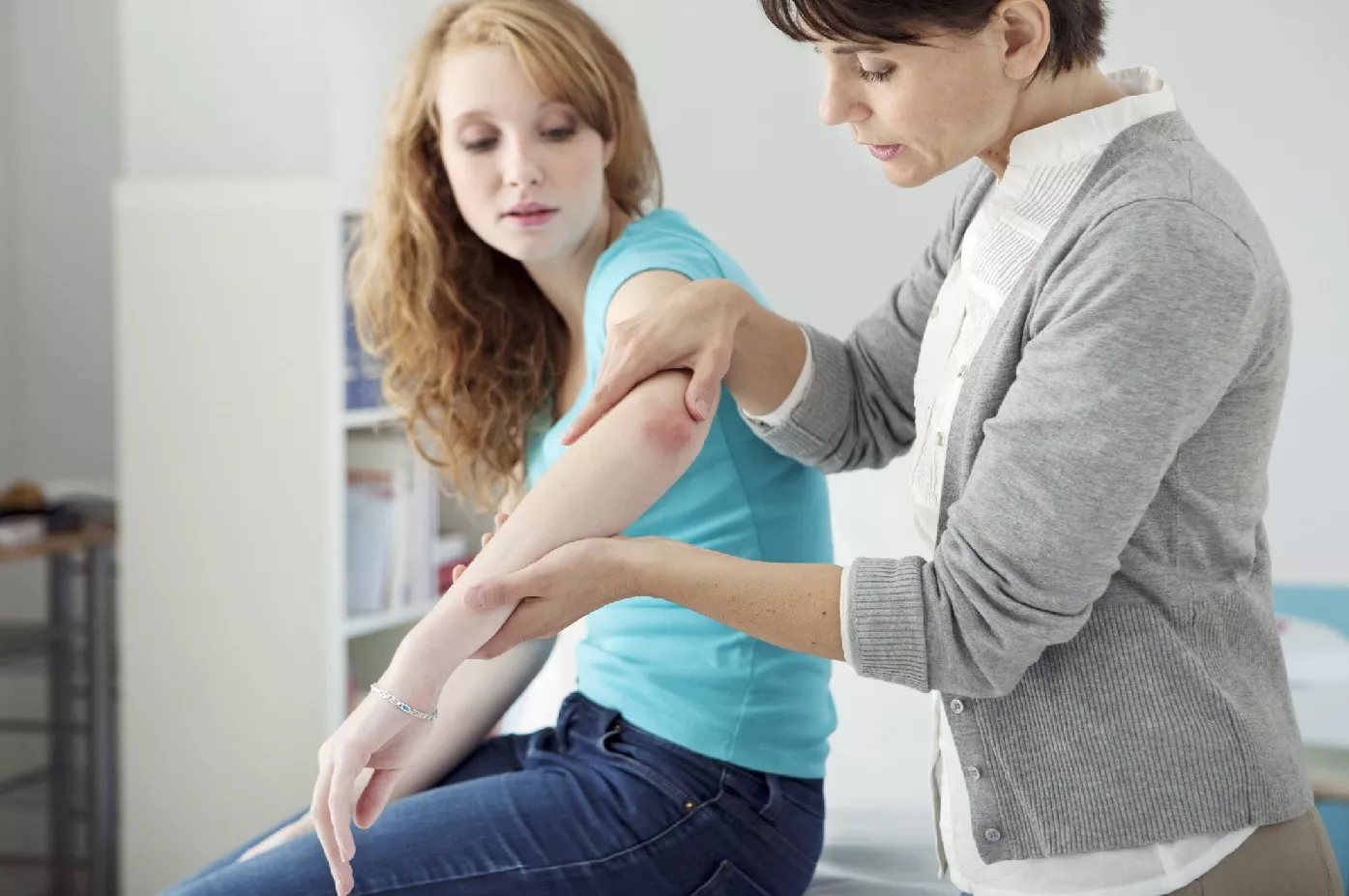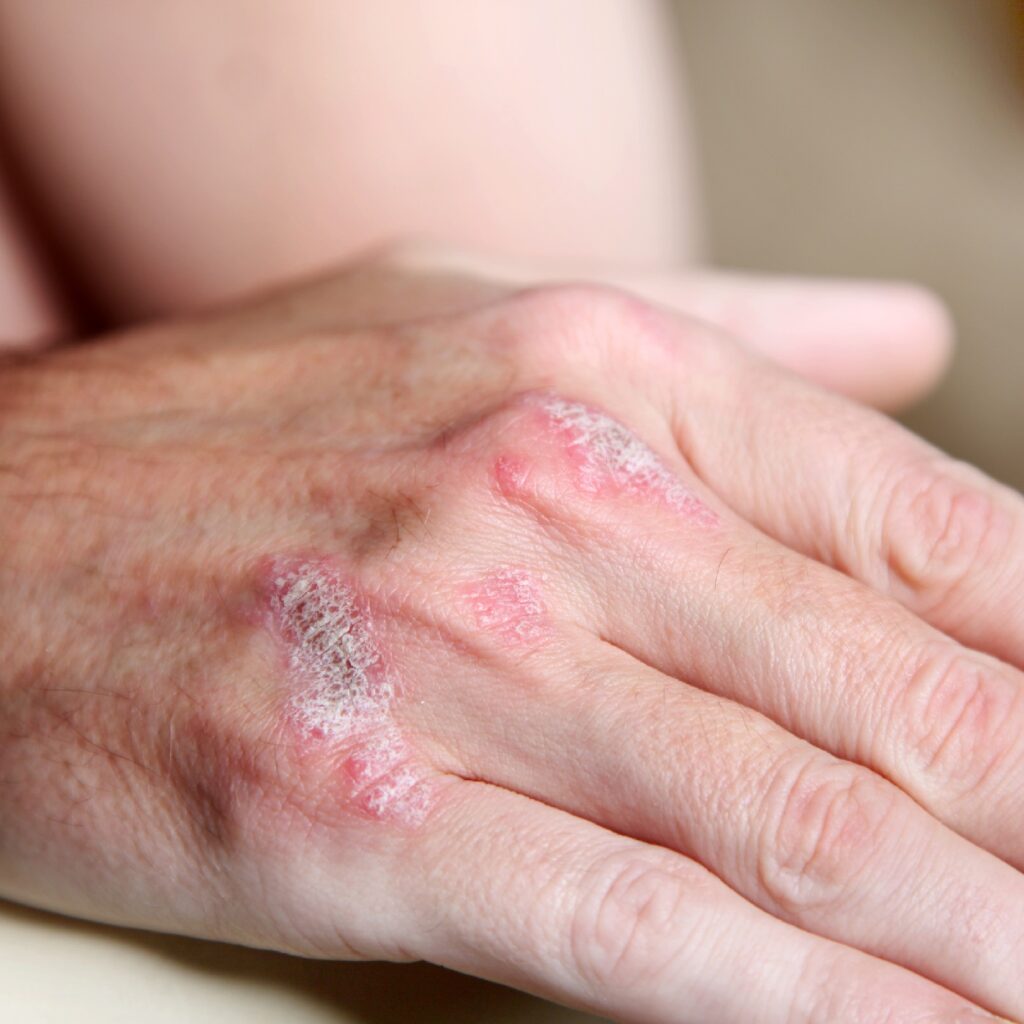Everything about Psoriasis – causes, symptoms, treatment

Definition and general information
Psoriasis is one of the common skin diseases. Thick, reddish plaques and silvery scales that cover the affected area are characteristic. The term “Psoriasis” is derived from Greek and means “an itching condition” (from Greek psora meaning “itch” and the suffix –sis standing for “action, condition”). The full name of the disease is often termed Psoriasis Vulgaris. This chronic and so far incurable skin disorder is immune-mediated and it usually occurs on lower back, scalp or joints – although it might also affect any other skin area. Not uncommon is the appearance of Psoriasis on body folds, finger nails or toe nails (psoriatic nail dystrophy). So far, no working cure has been found for Psoriasis Symptoms – the disease requires lifelong treatment and management.
What are the symptoms ?
The causes for the appearance of Psoriasis aren’t fully known, but dermatologists have recently made much progress in determining certain facts about the disease. It is understood that the troublesome skin disease cannot be passed from person to person (i.e. it is not contagious), however it often occurs among the members of the same family, thus pointing at the genetic character of the disorder. Psoriasis starts, as a result, of faults in the immune system, which takes healthy skin cells for pathogens, and causes the body to overproduce new skin cells. This new skin cells quickly accumulate, as they are created at a much faster rate than in healthy skin, which in turn leads to psoriatic changes in the form of scales and reddish plaques.
What causes it?
Psoriasis is most likely triggered and influenced by environmental factors – some of the local changes of psoriatic nature can be caused by so-called Koebner phenomenon – a skin injury. Some factors are found to have potential aggravating influence on an existing skin condition of Psoriasis: stress, oxidative stress, withdrawal of corticosteroids (which causes so-called “rebound effect”), etc. About one-third of all people affected by it also suffer from Psoriatic arthritis.
Remember, Psoriasis is a non-communicable skin disease!
The main role in the pathogenesis of Psoriasis play various immunological factors – the onset of the disease is conditioned by the malfunctioning of the immune system’s components – Lymphocytes T cells and the cytokines that are hidden by them. Although the functioning of the immune system is involved in the course of this disease, that isn’t perceived as a genuine autoimmune disease. The existence of common pathogenic mechanism has been found in Psoriasis and certain cardiovascular diseases. Psoriasis is a non-communicable and benign skin disease. It is characterised by a chronic course, with a tendency to spontaneous regression (remission) and relapse.
Types of Psoriasis
Apart from the most frequently occurring plaque Psoriasis, there are four other types of this skin disease: guttate, inverse, erythrodermic and pustular Psoriasis (according to the most frequently used categorization). Please continue reading to learn more about all the types of Psoriasis and the best ways to deal with its symptoms.
Symptoms
In the majority of cases, the first Psoriasis symptoms appear in early adulthood or later in life. Altogether, Psoriasis concerns about 2 – 4% of the population. The range of the skin areas covered by Psoriasis can vary from minor patches to full coverage of the body. Although this skin disorder can flare up and go into remission on its own in stages, in order to achieve control over its signs one needs to decide for the most effective Psoriasis treatment.
History
The earliest record of the disease that is presently known as Psoriasis might come from the Hebrew Bible, where it was mentioned among other skin conditions as tzaraath, and it was thought to be a form of punishment for slander. A person showing the symptoms of the disorder was deemed impure (according to Hebrew “tumah” and “taharah” terms that regarded one in terms of ritual purity) and was to be treated by a kohen (a Jewish priest). Since the biblical term tzaraath actually referred to many different skin conditions (in Hebrew tzara meant “to have a disease of the skin”). Once it had been translated into Greek as lepra, it led to confusing psoriasis with leprosy. Even though the Greeks used the term lepra for “scaly skin disorders,” while psora was used for “itchy conditions” the new (Greek) version of the bible.

Psoriasis on the hand bones
Only in the 18th century, an English dermatologist Robert Willan together with Thomas Bateman, distinguished it from other skin diseases and gave it a name Willan’s lepra. Willan’s distinction between regular leprosy (which he called leprosa graecorum) and one (known then as psora leprosa) was based solely on the shape of patches (regular or irregular) that formed on the skin.
Throughout the centuries, different treatments of dubious efficacy and possibly high toxicity were used to cope with Psoriasis. For example, the Ancient Egyptians are believed to have been topically applying cat faeces to red bumps and lesions on the skin. Several other treatments for this disease can be found in different records: from onions, urine, sea salt or goose oil to semen, soup of vipers and many other, most peculiar “remedies.”
By the late 18th and early 19th century, dermatologists were using so-called Fowler’s solution in treating Psoriasis. The substance contained highly poisonous, carcinogenic arsenic compound, but it wasn’t the only harmful treatment at that time, as the use of mercury was also very popular. Until the beginning of the 20th century, Psoriasis was believed to be an infectious disease, which is why treating it with iodine phenol or sulphur was also very common. Before the introduction of modern Psoriasis remedies, both coal tar and UV light irradiation had both been used – at least since the 1920s. Some of the presently available anti-Psoriasis Treatment still largely relies on coal tar.
Psoriasis classification
There are at least a few different ways to classify the chronic skin disease of Psoriasis. When taking the historical morphologic descriptions into account, this papulosquamous skin disorder occurs in few variants. No less common is the distinction between pustular and nonpustular Psoriasis, which are divided into the following Psoriasis subtypes:
Nonpustular Psoriasis:
- Psoriasis Vulgaris – the most common form of disease, often called plaque Psoriasis due to the characteristic red plaques that appear in this chronic and stationary skin disorder. This disease subtype concerns between 80 and 90% of all those who are affected. Its primary symptoms are usually patches of inflamed skin that are covered with whitish or silvery scales. In the majority of cases plaques appear on knees, elbows, lower back or scalp.
- Erythodermic Psoriasis – otherwise known as Psoriatic erythoderma; its main symptoms are skin’s inflammation and exfoliation that cover large surfaces of the body. Such symptoms of this subtype of disease are often accompanied by swelling, severe itching or even pain. This is often caused by the worsening condition of plaque Psoriasis, which often occurs after the sudden withdrawal of glucocorticoids from the system. The consequences of eyrthodermic Psoriasis are dire – it can even lead to death; (I.e. the skin no longer works as an effective barrier).
Pustular Psoriasis:
These forms of Psoriasis, although less common than the ones without any signs of pus, are still quite frequent. The raised skin bumps that appear in this Psoriasis subtype consists of non-infectious pus while the skin surrounding these pustules is red and soft (the lesional skin area is covered with an inflammatory reaction). The symptoms are usually found on patient’s hands or feet (known as palmoplantar pustulosis); they can also be randomly scattered across the whole body.
Pustular Psoriasis has the following subtypes:
- Generalised pustular Psoriasis (von Zumbush type) – a type of Psoriasis that occurs mostly among adults and has the most severe course. Psoriatic changes are accompanied by high fever, feeling of weakness, poor general health, and in some cases even life-threatening condition. The purulent pustules that appear within a time span of few hours (less than 24 hours) are present on the erythematous substrate and are grouped in packages. Also, present is the Nikolsky symptom leukocytosis in blood.
- Pustular Psoriasis of hands and feet (pustulosis palmaris et plantaris) – a rare Psoriasis subtype that is found mostly among women (they constitute 80% of all patients). It concerns predominant people in advanced age (50 to 60 years old). It’s eruptions usually occur on hands or feet, however with the exception of the distal parts of toes or fingers.
and also
- Impetigo herpetiformis – it is one of the most severe forms of pustular psoriasis, which appears during pregnancy and may in any of its stages. Treating with steroids is possible only with this subtype.
- Acrodermatitis continua (or dermatitis repens) – it is seldom occurring and sterile pustular eruption of toes and fingers that extends proximally.
- Annular pustular Psoriasis – a rare variant, which lesion morphology is annular or circinate, and which might appear at the pustular Psoriasis’s onset. It has a tendency to form enlarged rings and spread.
Other subtypes:
- Inverse Psoriasis (a.k.a. flexural psoriasis) – it appears as inflamed and smooth skin patches. Inverse Psoriasis occurs in skin folds – most frequently in the genitals area, on the armpits, between the buttocks; under the folds of an overweight abdomen or under the breasts. The main factors that are believed to have a large influence on the development of this rather uncommon disease subtype are trauma, infections and heat.
- Guttate Psoriasis – It is characterised by numerous, small and oval (guttate) dots. This numerous psoriatic spots over large body areas such as the torso. This form of psoriasis is associated with streptococcal pharyngitis.
- Nail Psoriasis is known to produce a wide variety of changes in the finger and toe nails’ appearance. This kind of disease concerns from 40 to 45% of people that are affected by some type of it; and the lifetime incidence of this skin disease is 80 to 90% among the patients who have been diagnosed with psoriatic arthritis. The changes include nails pitting; nail whitening, appearance of small bleeding areas under the nail (the bleeding occurs from capillaries); appearance of yellow-reddish nail discoloration commonly known as the “salmon spot” or “oil drop”; separation and loosening of nails (onycholysis), crumbling nails or sublingual hyperkeratosis, i.e. the skin under the nail becomes thicker.